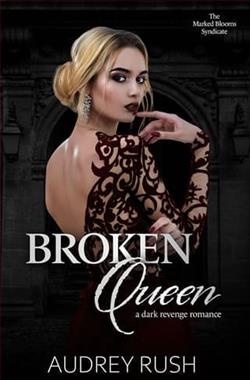Page 63 of A Column of Fire
Sylvie said bravely: ‘Don’t pretend, Papa, he knows what we are.’
Giles looked angry. ‘Did you tell him?’ He clenched a meaty fist.
Pierre said hastily: ‘She didn’t tell me. It’s obvious.’
Giles reddened. ‘Obvious?’
‘To anyone who looks around – at all the things missing from your home. There is no crucifix over your bed, no statue of the Virgin in a niche by the door, no painting of the Holy Family above the mantelpiece. Your wife has no pearls sewn into the fabric of her best dress, although you could afford a few. Your daughter wears a brown coat.’ He reached across the table with a swift movement and snatched the book from under Guillaume’s hand. Opening it, he said: ‘And you read the Gospel of St Matthew in French on a Sunday morning.’
Guillaume spoke for the first time. ‘Are you going to denounce us?’ He looked scared.
‘No, Guillaume. If that was my intention, I would have come here with officers of the city guard.’ Pierre returned his gaze to Giles. ‘I want to join you. I want to become a Protestant. And I want to marry Sylvie.’
Sylvie said: ‘Please say yes, Papa.’ She knelt in front of her father. ‘Pierre loves me and I love him. We’re going to be so happy together. And Pierre will join us in our work of spreading the true gospel.’
Giles’s fist unclenched and his colour returned to normal. He said to Pierre: ‘Will you?’
‘Yes,’ said Pierre. ‘If you’ll have me.’
Giles looked at his wife. Isabelle gave an almost imperceptible nod. Pierre suspected that she was the real power in this family, despite appearances. Giles smiled – a rare thing – and spoke to Sylvie. ‘Very well, then. Marry Pierre, and may God bless your union.’
Sylvie jumped up, hugged her father, then exuberantly kissed Pierre. By coincidence there was a cheer from the crowd in front of the cathedral. ‘They approve of our engagement,’ Pierre said, and everyone laughed.
They all went to the windows, which overlooked the square. The wedding procession was moving along the scaffolded stage. It was led by a company of soldiers known as the Hundred Swiss, identifiable by their striped sleeves and the feathers in their helmets. As Pierre watched, a large group of musicians came into view, playing flutes and drums, then the gentlemen of the court, every one of them in new clothes, a riot of red, gold, bright blue, yellow and lavender. Sylvie said excitedly: ‘It’s as if they’re doing it for you and me, Pierre!’
The crowd fell silent and bowed their heads as the bishops appeared carrying jewelled crucifixes and holy relics housed in gorgeous gold reliquaries. Pierre spotted Cardinal Charles in his red robes bearing a gold chalice decorated with precious stones.
At last the bridegroom appeared. The fourteen-year-old Francis looked terrified. He was thin and frail, and all the jewels in his hat and coat could not make him into a kingly figure. Beside him was King Antoine of Navarre, head of the Bourbon family, the enemies of the Guises. Pierre guessed that someone – perhaps the ever-careful Queen Caterina – had given Antoine this privileged placement as a counterweight to the Guise family, who threatened to dominate the ceremony.
Then the spectators went wild to see the king himself, Henri II, and their war hero, Duke Scarface, walking on either side of the bride.
She wore a dress of pure white.
‘White?’ said Isabelle, standing behind Pierre and looking over his shoulder. White was the colour of mourning. ‘She’s wearing white?’
*
ALISONMCKAY HADbeen against the white wedding dress. White was the colour of mourning in France. She feared it would shock people. And it made Mary Stuart look even paler than usual. But Mary could be stubborn, and was as opinionated as any fifteen-year-old, especially about clothing. She had wanted white, and would not even discuss alternatives.
And it had worked. The silk seemed to glow with the purity of Mary’s virginity. Over it she wore a mantle of pale blue-grey velvet that shimmered in the April sunlight like the surface of the river that ran alongside the cathedral. The train, of the same material, was heavy, as Alison knew well, for she was one of the two girls carrying it.
Mary wore a golden coronet studded with diamonds, pearls, rubies and sapphires: Alison guessed she must be desperate to take the weight off her head. Around her neck Mary had an enormous jewelled pendant that she had named ‘Great Harry’ because it was a gift from King Henri.
With her red hair and white skin Mary looked like an angel, and the people loved her. As she advanced on the raised platform, holding the king’s arm, the roar of approval moved like a slow wave along the massed ranks of spectators, keeping pace with the progress of the bride.
Alison was a minor figure in this galaxy of royal and noble people, but she basked in the reflected glory of her best friend. Mary and Alison had talked and dreamed of their weddings for as long as she could remember, but this outshone anything they had imagined. It was the justification of Mary’s existence. Alison rejoiced for her friend and for herself.
They reached the canopied dais where the groom was waiting.
When the bride and groom stood side by side it was comically obvious that she was a foot taller than he, and there was laughter and some jeering from unruly elements in the crowd. Then the couple knelt down in front of the archbishop of Rouen, and the tableau became less risible.
The king took a ring from his own finger and handed it to the archbishop, and the ceremony began.
Mary made her responses loudly and clearly, while Francis spoke in a low voice so that the crowd would not laugh at his stammer.
Alison recalled, in a flash of memory, that Mary had been wearing white the first time they met. Both Alison’s parents had just died of the plague, and she was living in the cold house of her widowed Aunt Janice, a friend of Mary’s mother, Marie de Guise. As a kindness, the new orphan was taken to play with the four-year-old queen of Scotland. Mary’s nursery was a place of blazing fires and soft cushions and beautiful toys, and while there Alison could forget that she had no mother.
Her visits became frequent. Little Mary looked up to her six-year-old friend. Alison felt rescued from the solemn atmosphere of Aunt Janice’s house. After a happy year, they were told that Mary was going away, to live in France. Alison was heartbroken. But Mary, showing early signs of the imperious adult she would become, threw a tantrum and insisted that Alison had to go to France with her; and in the end she got her way.















